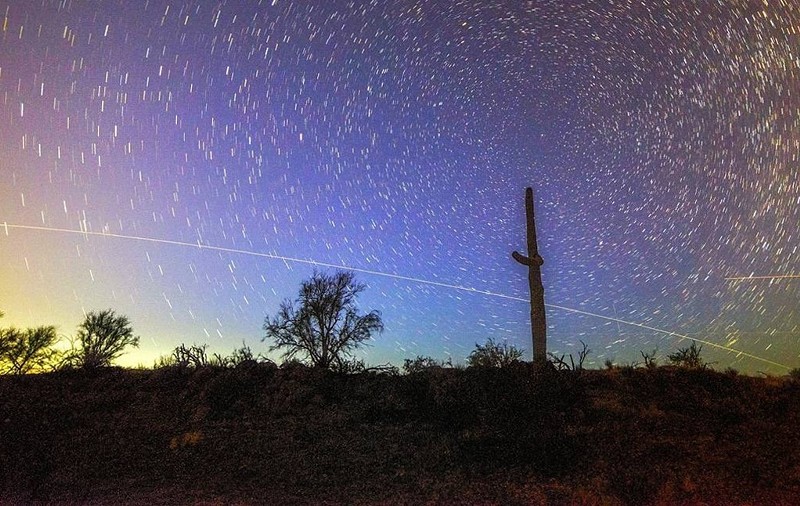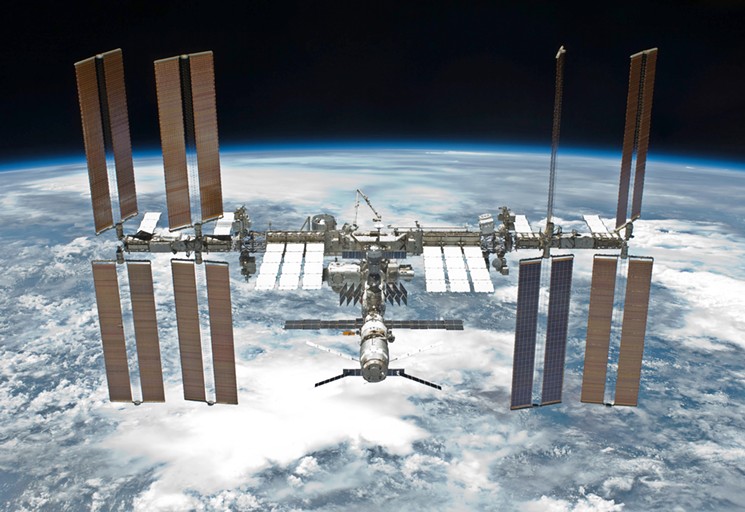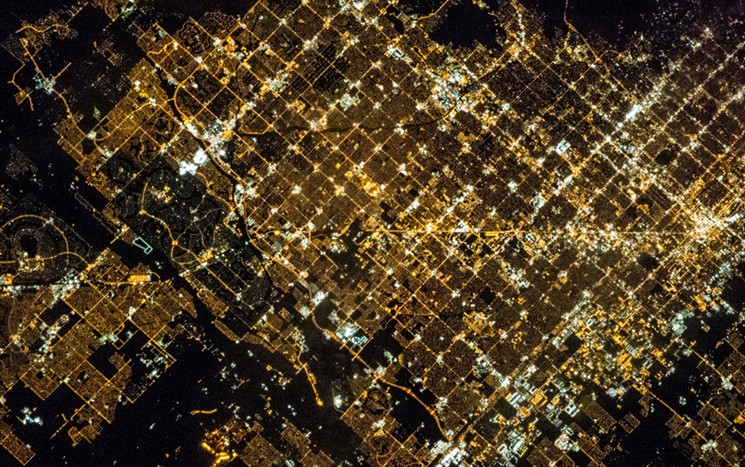Skywatchers of Arizona can catch a glimpse of the Earth’s largest man-made object in orbit this week as it glides overhead. The International Space Station will buzz our state during the next few nights when it makes several highly visible passes.
And folks like Claude Haynes of the East Valley Astronomy Club say it's a sight worth seeing, even if it only lasts for a few minutes.
“Whenever the International Space Station flies overhead, it's pretty spectacular,” Haynes says. “It's fun and always causes some ‘oohs’ and ‘ahhs.’"
The station, which is approximately 254 miles above the Earth, regularly passes over Arizona as it orbits our planet every 90 minutes, but only becomes visible at night a handful of times each month.
“There are only a few orbits where [the ISS] reflects enough sunlight to be visible from a certain location,” Haynes says. “A lot of these passes will be low to the horizon, but sometimes the station will come directly overhead and will look like a bright, first magnitude star that's moving across the sky.”
This week, those highly visible passes will happen nightly from Tuesday, September 15, to Sunday, September 20, as the ISS reflects sunlight from its numerous solar panels before entering the Earth’s shadow. Each of these highly visible passes will last anywhere from three to eight minutes and will resemble an airplane jetting across the sky.
“It's rather sudden and spectacular,” Haynes says. “It will be bright for several minutes and then go dim and almost disappear.”
If you’d like to spot the station during its flyover (or wave at the astronauts inside), the good news is that you can do it from your front or back yard. Here’s everything you’ll need to know in order to do it.
Why Will the ISS Be More Visible Over Arizona This Week?
As we said, the ISS passes over Arizona a few times each day while orbiting the Earth. Every few weeks, some of the station’s nighttime orbits are more visible because its solar panels will reflect more sunlight than usual.When And Where Can You See It This Week?
You’ll have a total of five opportunities to catch highly visible flyovers of Arizona by the ISS. The brightest and most prominent viewings will happen beginning at 7:31 p.m. on Thursday, September 17, and beginning at 6:44 p.m. on Friday, September 18. Slightly less visible flyovers will take place on Tuesday, September 15; Wednesday, September 16; and Sunday, September 20.Here's a full rundown of when and where to look:
Tuesday, September 15
Elevation: 36 degrees above the horizon
Visible at 7:29 p.m. in the southern sky (200 degrees)
Peak intensity at 7:32 p.m. in the southeastern sky (137 degrees)
Passes into shadow at 7:34 p.m. in the eastern sky (78 degrees)
Wednesday, September 16
Elevation: 30 degrees above the horizon
Visible at 8:20 p.m. in the western sky (200 degrees)
Peak intensity at 8:22 p.m. in the northwestern sky (320 degrees)
Passes into shadow at 8:23 p.m. in the northwestern sky (352 degrees)
Thursday, September 17 (Best Opportunity)
Elevation: 52 degrees above the horizon (basically overhead)
Visible at 7:31 p.m. in the southwestern sky (239 degrees)
Peak intensity at 7:34 p.m. in the northwestern sky (294 degrees)
Passes into shadow at 7:38 p.m. in the northeastern sky (40 degrees)
Friday, September 18 (Best Opportunity)
Elevation: 74 degrees above the horizon
Visible at 6:44 p.m. in the southwestern sky (220 degrees)
Peak intensity at 6:47 p.m. in the eastern sky (111 degrees)
Passes into shadow at 6:52 p.m. in the northeastern sky (48 degrees)
Sunday, September 20
Elevation: 30 degrees above the horizon
Visible at 6:47 p.m. in the western sky (268 degrees)
Peak intensity at 6:49 p.m. in the northwestern sky (320 degrees)
Passes into shadow at 6:54 p.m. in the northeastern sky (38 degrees)
What Will Viewing Conditions Be Like?
The current weather forecast calls for nothing but clear skies over the next week, which means optimal viewing will be available every night the ISS is visible.Where Is the Best Place to See the ISS Flyovers?
Pretty much anywhere the nighttime sky is visible. The flyovers on Thursday and Friday nights will be higher in the sky and brighter than on other nights this week. You can remain in your front or back yards and still see the flyovers.Are There Any Apps You Can Use to Help See the Flyovers?
Yes. If you’ve got an iPhone, we recommend using the ISS Spotter app, which has a built-in compass to help you locate the ISS. If you’re using an Android device, try the ISS Detector. Both are free. The SatelliteTracker is also available for both phone types and offers a real-time view of the sky that will pinpoint the current location of the ISS. A compass app, which is available on practically every type of smartphone these days, also will help.Will You Need a Telescope or Binoculars?
Nope. The ISS will be visible to the naked eye.What Will the ISS Look Like During the Flyovers?
Basically, it will be about as bright and swift-moving as an airplane flying overhead, only without the red and green navigation lights. “It will also be brighter than most of the stars out, but it won’t be flickering,” Haynes says. “The ISS will be constantly bright as it glides across the sky.”Editor's note: This story was originally published on June 2 and has been updated.















